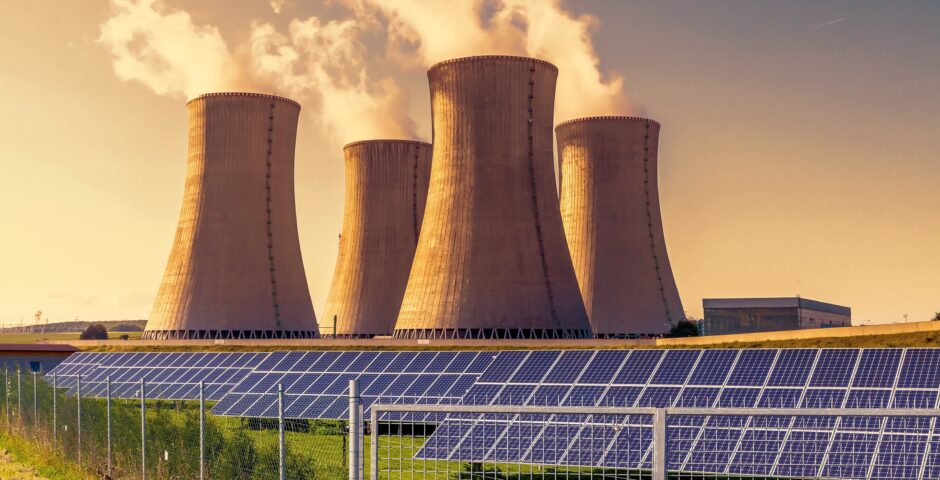Nuclear energy: a necessary technology for a green EU or a dangerous distraction?

Arriving at COP26
This week world leaders meet at the 26th conference of the parties, or COP26 for short, with the aim of charting a path towards a sustainable future for humanity. This currently involves a widely shared pledge for net-zero emissions by 2050 and a global temperature increase of no more than 1.5℃. The meeting was always going to be fraught with challenges; striking a compromise that guarantees the necessary reduction in global carbon emissions involves spanning great developmental, ideological and geographical distances. The mission faces an uncountable number of hurdles, among which the need for an agreement on each country’s NDC (nationally determined contribution), the desire (and need) for economic development in the global south, a resolution of the dispute between the developed and developing world regarding technology transfer and financial assistance, and political concerns about the burdens placed on industry, to name just a few.
At the same time, the world faces the first big energy crisis of the 21st century. Over the past 3 months, the price of oil, coal and gas has soared by over 95% on average, leading to concerns about the reliability of the EU’s energy supply as we head into winter. For decades, Europeans have enjoyed unparalleled energy stability, leading many to forget that their modern lives are in large part dependent on the uninterrupted supply of electricity and gas to both their homes and workplaces. The crisis is a stark reminder of Europe’s insecurity on this front and has triggered varied responses from across the Union, mostly aimed at protecting consumers and producers from excessively high energy costs.
However, while shielding society from the most direct impact of rising prices might, at great expense to taxpayers, alleviate the situation in the short term, it is not a sustainable solution. A more long term approach will entail finding a sustainable source of energy, preferably without impacting the climate nor increasing the EU’s reliance on autocratic yet energy-rich Russia.
Developing Europe’s future energy mix
In the long run, this alternative source is bound to be some mix of renewables, but unfortunately this is unfeasible in the short run. To some, if not most, this might be a surprising or uncomfortable notion. After all, politicians from across the Union have touted wind and solar as the sources of energy for the 21st century. What most fail to discuss however, is what to do when there is a lack of wind or sunshine. The weather is ever changing, and while there is plenty of potential to generate all of Europe’s energy with wind and solar, the reality is that these sources are highly unstable. In the future, this instability in production might be mitigated with some combination of battery or hydrogen storage, but implementing this at the scale required to guarantee energy supply is still decades away. In the meantime, European politicians attending COP26 will need to find an alternative that will both secure supply and allow for the necessary reduction in greenhouse gas emissions.
While it has become quite unpopular, this alternative can and perhaps has to be nuclear energy. Nuclear energy has faced a difficult reputation in the European Union, owing to its high startup costs, long construction times, and potential risk factors. Yet at the same time, it is also a reliable source of low-carbon electricity which can serve as a backstop for moments when renewable (absent effective storage technology) electricity is in short supply. Perhaps one of the key questions that needs to be answered then is whether nuclear is actually green. For this, we can look at an influential report by the Intergovernmental Panel on Climate Change in 2014. In it, the environmental impacts of different energy technologies are compared for both their direct greenhouse-gas emissions and full-life-cycle emissions. This latter point is interesting, as it is often overlooked in the cost-benefit analysis of wind and solar. As the report points out, even renewable-energy technologies produce waste. Not only are the materials used in solar panels and wind turbines often toxic to the environment, but also the volume of waste alone can be of significant concern, leading to landfills full of wind turbines for example. All this means that, after including the impact of mining, extraction and enrichment, the emissions from nuclear energy are on par with wind and solar power.
Assessing the nuclear option
Of course there are more concerns with nuclear energy than just the environmental impact. One of these concerns is nuclear waste, a byproduct of generating nuclear energy. Compared to other energy sources, waste from nuclear energy must be stored for thousands of years before it no longer poses a risk to human health or the environment. This may sound scary, but the volumes involved are small, and highly regulated waste storages are being used to prevent radiation leaks. Another common talking point is the high cost of nuclear energy; after all, the levelized cost of nuclear energy is twice that of solar and onshore wind. Yet, while it’s true that nuclear energy is more costly than solar and wind, it is also the most reliable. Where nuclear power plants can produce maximum power for 92.5% of the year, solar and wind can only do so for 24.9% and 35.4% respectively. As such, nuclear energy can generate the baseload power necessary to keep the grid continuously operational, to achieve this with only wind and solar energy is currently a technical impossibility. And even if it were possible, the costs of building the required energy storage capacity would be so large as to make it financially unsensible. One more downside of nuclear energy is that on average it takes between five and ten years to build a new power plant. As a result, nuclear energy is only a feasible solution for sustainable energy generation in the medium to long-term, as well as making it susceptible to changes in the political climate of a country.
Undeniably there are also benefits to nuclear energy generation. To start, it ensures that the baseload required for an operational grid is generated from a sustainable energy source. Currently this baseload is often generated in oil and/or gas based power plants, which make European countries dependent on fossil fuel suppliers such as Russia who can use this dependency to exert geopolitical pressure. Consequently, nuclear energy contributes to increasing the energy independence and the reliability of the energy supply of the EU. A secondary benefit of this sustainable baseload is the freedom to experiment and innovate with currently inconsistent sources of green energy, such as the capture of energy in ocean waves. This is in addition to the scientific research and (commercial) innovation that accompanies nuclear energy generation.
A role to play
While nuclear energy is not the solution to all of Europe’s energy problems it certainly has a part to play in the European transition towards a green, reliable and secure energy supply. The high costs, the storage of radioactive waste, and the need for long-term political commitment make it at times difficult to see the benefits of nuclear energy. However, as we discussed in this article, the risks of nuclear energy might have to be accepted to ensure that Europe has access to a reliable and sustainable energy supply until completely renewable energy production and storage has been achieved. This ambition is especially important in the present day, where the high costs of gas might undermine the population’s willingness to accept measures to combat climate change in the present, and even increase climate skepticism. Both would yield dire consequences for the world.
Marnix Vermeer obtained a Master in Economics: Global challenges and macroeconomic policy from Maastricht University, and is currently pursuing a Master in International Relations in Barcelona.
Daniel Niekel is a graduate of the Rijksuniversiteit Groningen with a master’s in International Business & Management.
Image: Shutterstock




